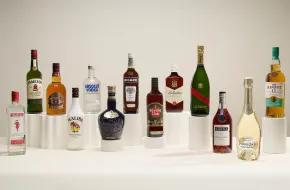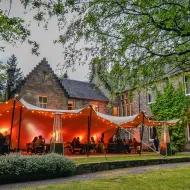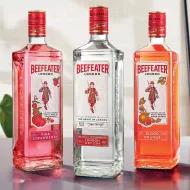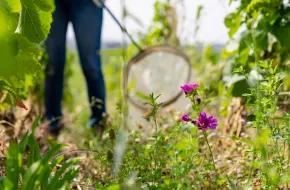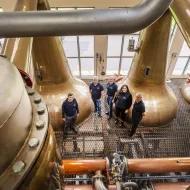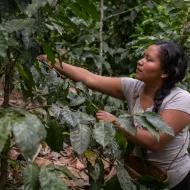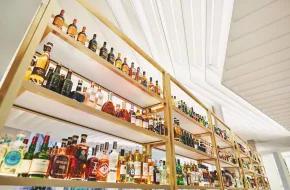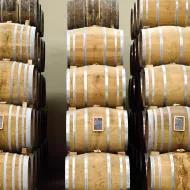Champagne is the fruit of a long and complex production method. Most of the bottles of champagne represents at least 15 months of preparation ' or 3 years for millésime champagnes. Discover every step in the champagne production process, blending tradition, know-how and excellence.
Champagne is the fruit of a long and complex production method. Most of the bottles of champagne represents at least 15 months of preparation ' or 3 years for millésime champagnes. Discover every step in the champagne production process, blending tradition, know-how and excellence.
Discover the infographics about the Champagne production method
 1. Vine cultivation and grape harvests
1. Vine cultivation and grape harvests
In November, the leaves have fallen and pre-pruning begins in order to prepare the vine for winter's arrival. Between December and mid-January, the vine withers during the winter rest period, or dormancy.
When springtime arrives, seasonal growth returns (after the 'budburst'). In mid-May, the first job is to remove any non-fruitful buds so the vine can focus its sap on the primary buds ('desuckering' step). Finally, in June, 'palissage' occurs, a step that consists of separating the shoots and holding them in place by stapling them to wires.
In the summer, as soon as flowering ends (sometime around June), the period of pollination (or 'fruit setting') begins for a period of up to 10 days maximum. Next, the grapes change color and swell with sugar ' which is called 'véraison' or ripening. To keep the vine from producing foliage instead of fruit, 'summer thinning' or 'pinching back' is performed starting in late June or early July and lasting until the grape harvest.
Fall is the grape harvest season. In Champagne, picking (also known as 'épluchage') is done primarily by hand. Grapes are gathered in wide, shallow baskets to keep them whole and undamaged. Pruning begins immediately after the harvest, using techniques governed by official regulations since 1938.
2. Pressing and settling
Grapes are weighed and recorded as soon as they arrive at the pressing center. Each 'marc' (traditional unit of measurement representing 4,000 kg of grapes) is recorded ina pressing logbook, noting details of the cru and grape variety. The logbook may be retained by the producer or sold to a Champagne House. Grapes are also tested for compliance with the minimum alcohol content for each vintage.
Next comes the 'débourbage' process, which involves the natural settling of juices. This step ferments clean juices to produce wines with notes of fruit and pure flavors.
3. Fermentation
Two fermentation phases ' alcoholic involving yeast and malolactic involving bacteria ' serve to generate the flavors and style of each champagne variety.
4. Blending
The head wine waiter blends different wines in order to create a cuvee presenting specific characteristics. An essential step in the winemaking process, 'blending' gives each wine its distinctive character, based notably on the spirit of the Champagne House producing the wine.
After blending, cold stabilization aims to achieve the perfect stabilization of the champagne. Clarification then leaves the wine completely clear by removing any particles suspended in the blend.
5. Second fermentation
During the bottling process, the winemaker adds the liqueur de tirage (a sweet blend of 1 kg of cane or beet sugar per liter of old wine), which initiates the second fermentation period lasting for 6-8 weeks.
6. Maturation, ageing and riddling
Full champagne bottles are stacked and stored in chalk cellars where they are kept at a cool and constant temperature for a minimum of 15 months before their commercial release.
Starting in the 8th month, yeast transforms the sugar added during the second fermentation process into alcohol and carbonation; this in turn produces a bubbly mousse once it dissolves into the wine. After converting the sugar into alcohol, the yeast dies and forms a deposit on the walls of the bottle that the winemaker must remove.
The bottles are then placed on a riddling rack, known as a pupitre, with the neck angled downward. Bottles are then rotated by 1/8th of a turn in each direction and gradually shifted to a vertical position, so that the lees collect in the neck of the bottle. Known as 'riddling' or 'remuage,' this step lasts from 2 weeks to 3 months.
7. Disgorgement and dosage
Once concentrated in the neck of the bottle, the sediment deposit can be removed: this stage is called 'disgorgement.' The most common method for this process is disgorgement with ice. The bottle neck is plunged into a refrigerating solution at -20/-30°C. An ice plug forms and traps the sediment deposit, which is then ejected under pressure when the bottle is opened.
To restore the wine's natural acidity and its carbonation level, the winemaker adds a dosage liqueur, also known as 'shipping liqueur.' This solution consists of refrigerated reserve wine combined with a level of sugar that varies depending on the type of champagne. This is the finishing touch lent by the cellar master before final corking. Bottles must then rest for 2-4 months so that the dosage liqueur blends perfectly with the rest of the wine.
Read also:
Tags
On the same topic
-
Q1 FY26 Sales
Read moreSlow start to the year as expected, with declines in China and USA leading to Q1 organic net sales -7.6% and reported -14.3%
-
Invitation - FY26 First Quarter Sales & Results
Read more -
Filing of Pernod Ricard’s 2024/25 Universal Registration Document
Read morePernod Ricard filed its 2024/25 Universal Registration Document with the Autorité des Marchés Financiers (AMF) on September 17th, 2025 under number D.25-0638.









